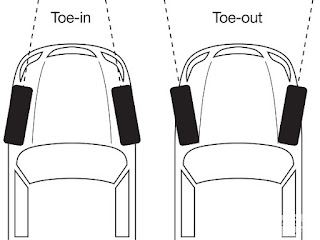Definition :
Toe-in is the amount by which the front wheels are mounted closer together on the front than on the back when the vehicle is stationary and viewed from the top. The wheel can be set closer to the rear than to the front, in which case the difference of the distances between the front and rear wheels is called toe-out.
Effect :
In rear-wheel-drive vehicles, there is usually an inherent tendency for the wheels to toe-out due to purposeful deviation from centre point steering due to errors in the steering angles of the inner and outer bends of the wheels.
There is usually an inherent tendency for the wheels to toe-out in rear-wheel drive vehicles just because of purposeful deviation from centre point steering due to errors in steering angles of the inner and outer wheels bends. In order to compensate for this tendency, a small amount of toe-in was initially provided in such vehicles so that the wheels move perfectly straight ahead under normal turning condition. However, the initial toe-out was provided in the case of some front-wheel-drive vehicles to counter the toe-in present therein.
In rear-wheel-drive vehicles, due to errors in the steering angles of the inner and outer bends of the wheels, there is usually an inherent tendency for the wheels to toe out.
In rear-wheel-drive vehicles, there is usually an inherent tendency for the wheels to toe out due to purposeful deviation from centre point steering due to errors in the steering angles of the inner and outer bends of the wheels. A small amount of toe-in was initially provided in such vehicles to compensate for this tendency so that the wheels move perfectly straight ahead under the normal turning conditions.
Toe-in generally does not exceed 3 mm.
A toe-in wheel alignment can help to reduce oversteer problems and increase stability in front-wheel drives vehicles.
A toe-out alignment can help to mitigate issues related to understeering and can improve the handling of a vehicle that has rear-wheel drive.
Explore more information:

